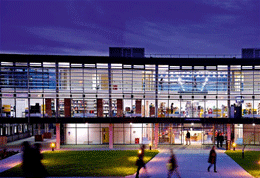25th Nov 2015 5:00pm-6:30pm
M2 Boardroom, Grand Parade
Talk

Julia Winckler, PhD Candidate, University of Brighton
'Fabricating Lureland: tracking a utopian vision for Peacehaven via the Peacehaven Post magazine Vol. 1, 1921-22'
Abstract: In Peacehaven, as in many speculative developments, we can find evidence of collision between the ideas articulated in marketing discourses and their actual realization. A post WW1 development, the town was started by developer Charles Neville’s South Coast Land and Resort Company. An astute, and well-connected businessman, Neville drew on a range of discourses and means to attract buyers for this freehold development. In 1921 he brought together a host of “celebrities” - writers, composers and artists - who helped “fabricate” and endorse a vision and a marketing strategy for the new estate.
The artist Gordon Volk was instrumental in visualizing Peacehaven’s promise through cartoons he made for the monthly Peacehaven Post. George and Felix Powell (composers of WW1 hit Pack Up Your Troubles) wrote the song Come to Peacehaven, with George Powell becoming the Post’s first editor. The writer George R. Sims (author of Horrible London (1889), How the Poor live (1883) and Dagonet Ballads (1879)) came up with the epithet of Lureland in the Post’s first editorial.
“Land ahoy” “What land?” “Why, my land, your land, our land. Care free and freehold happy land – LURELAND” (Vol 1, p.1, Sept. 1921).
Volk’s cartoons and drawings for the Post, alongside editorials by Sims and the Powell’sepitomize the “two faces” of Utopia. Not only do they already anticipate a future for Peacehaven, a place that is itself only beginning to emerge. Moreover, they articulate expressions of a shared past in a not yet existing present, giving the impression of reliability, solidity and connection to tradition. By using polysemic symbols such as anchors, pillars, a globe and a shepherd and his flock, the Post deployed visual metaphors to create a connection, or the illusion of a connection, to the past. George R. Sims also referred to Peacehaven as “a second Eden” (Vol. 1, No. 3, page 59) working with the “myth of the eternal return” (Eliade).
A drawing entitled: “The Twelve “Posts” of Peacehaven” conceives of a shared present defined by:
Health, happiness, contentment, recreation, satisfaction, freedom, hope, rejuvenation, home-life, prosperity, peace, and a haven (Vol.1).
Already imagining an entire community of not yet existing settlers, Volk’s cartoons also show what is “not seen at Peacehaven!” Rent collectors, pawnshops, factories, city congestion and child poverty. (Vol.1, No.6, Feb 1922)
On the one hand, these were of course reassuring lines that located the idea of Peacehaven where developers wanted it to be – by the same token, they captured the imagination of a Post WW1 public afraid of the health risks that overcrowding and squalor brought with them in the capital and the social reform movement. This narrative further appealed to entrepreneurial folk who liked the idea of taking on smallholdings after the war and also tapped into Ebenezer Howard’s Garden city ideal.
Working with the idea of Utopia as “two-faced” – “imagining a not yet existing place” versus “the place where the good life could finally be realised”, I propose to track how a utopian vision for Peacehaven was first articulated through cartoons, editorials and photographs published in the Peacehaven Post when building at Peacehaven had only barely commenced.
Ken Clarry, PhD candidate, University of Brighton
'Beyond the Fire – Bread as a weapon of war'
The Syrian government’s military began to use bread as a weapon of war in 2012 when it started bombing bakeries and breadlines within strongholds and cities in Syria controlled by opposition groups. The bakery bombings and siege strategy exploit the basic principle of starvation warfare: the belief that people will do anything and risk anything when anxious to feed their families and themselves. In spite of the danger, and with no other options available, people endangered their lives by standing in queues outside bakeries for bread. The presentation will introduce the contextual and theoretical workings of the images, Beyond the Fire.
This presentation given by Ken Clarry is an extract from a much wider exploration of multi-disciplinary research of art practice and theory into the Spectre of Violence in Contemporary Art Practice. He is an artist in his third year of MPhil/PhD study at the University of Brighton Faculty of Arts and Humanities.
The Arts and Humanities Research Forum (AHRF) is a research forum for staff and students in the University’s Arts and Humanities College generated by the Doctoral College and the Centre for Research and Development The AHRF is a fortnightly event series open to all research students and staff as well as open to the public as audience members. The forum provides a regular facilitative context in which researchers can trial or rehearse research designs, argue for and justify appropriate methodological approaches and frameworks, and debate theory/practice relationships in their studies.
Please contact J.Lane2@Brighton.ac.uk for further details